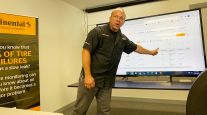Study Shows Low-Rolling-Resistance Tires Aid Fuel Efficiency, Reduce Cost
“Low-rolling-resistance tires, whether in dual or wide-base configurations, are proven to save fleets fuel and therefore have a good case for adoption,” Mike Roeth, executive director of the North American Council for Fleet Efficiency, said in a report issued Aug. 14 as part of an ongoing study of trucking efficiency.
Roeth said the rate of adoption for low-rolling-resistance tires already is high and should continue to increase as manufacturers develop new tires with even less rolling resistance properties.
“These super-low-rolling-resistance tires will use extensive chemical blends and a combination of three, four or five materials,” Roeth said.
More than 100 commercial truck tires are considered by the U.S. Environmental Protection Agency to have fuel-saving properties based on a measure of rolling resistance that compares weight and the force needed to keep tires rolling.
The precise number — the rolling resistance coefficient — is closely guarded by tire manufacturers and can vary widely among tires that are promoted as fuel-efficient, Roeth said.
“We need more transparency in the data,” he said.
Among drive tires that EPA has verified as part of its SmartWay Transport Partnership program, for example, the rolling resistance coefficient number ranges from 4.5 to 9, Roeth said.
Since 2013, NACFE has issued Trucking Efficiency Confidence Reports on tire pressure monitoring, 6x2 axle systems, idle reduction systems and electronically controlled transmissions and engines.
Another report on lightweighting is due to be released Aug. 25, and subsequent reports will be released at a rate of one per month over the next six months, Roeth said. Future reports will address engine speed, maintenance, trailer and tractor aerodynamics, and possibly lubricants and driver coaching, he said.




